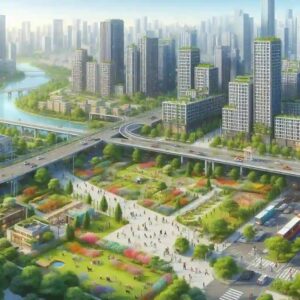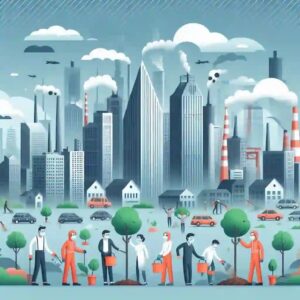
Essay on Pollution Due to Urbanization
 |
| Urban area |
Introduction
Urbanization, the technique with the aid of which an growing share of a populace lives in cities and suburbs, is a trademark of modern-day development. While it brings economic boom and stepped forward living requirements, it additionally introduces full-size environmental challenges, specifically pollution. Pollution as a result of urbanization manifests in numerous bureaucracy, together with air, water, noise, and soil pollution, each with wonderful reasons and excessive effects.
Causes of Urbanization
Industrialization
Industrialization is a primary motive force of urbanization. As industries grow, they entice people from rural regions searching for employment possibilities. The concentration of factories and commercial plants in urban areas ends in multiplied emissions of pollutants, such as greenhouse gases and particulate count. These emissions make a contribution significantly to air and water pollution, impacting each the environment and human fitness.
Population Growth
The migration of people to city areas for higher living conditions and task opportunities results in population growth. This rapid boom in city population strains infrastructure and resources, resulting in insufficient waste management structures, overburdened public shipping, and expanded vehicular emissions. The cumulative effect of those factors exacerbates pollution levels, developing an unhealthy residing environment.
Economic Opportunities
Urban areas regularly provide better financial opportunities, including higher wages, higher training, and healthcare facilities. This financial pull component quickens urbanization, but it additionally brings demanding situations. Increased call for for housing, transportation, and services results in extra electricity intake and waste manufacturing, contributing to diverse forms of pollution.
 |
| Pollution |
Types of Pollution Due to Urbanization
Air Pollution
Sources of Air Pollution
Air pollution in city regions in most cases originates from automobile emissions, industrial discharges, and production sports. The burning of fossil fuels for transportation and strength manufacturing releases pollutants like carbon monoxide, sulfur dioxide, nitrogen oxides, and particulate be counted into the atmosphere. Additionally, creation dust and emissions from manufacturing methods further degrade air high-quality.
Effects on Health
Air pollution poses widespread fitness dangers, inclusive of breathing illnesses consisting of allergies and chronic bronchitis, cardiovascular issues, or even premature death. Long-time period exposure to polluted air can cause lung cancer and adversely affect kid’s improvement. Vulnerable populations, which includes the elderly and those with preexisting fitness conditions, are in particular at hazard.
Mitigation Measures
To fight air pollutants, cities can implement numerous mitigation measures. Promoting public transportation, adopting stricter emissions standards for automobiles and industries, and inspiring the use of electric powered motors can drastically lessen air pollution. Additionally, planting extra bushes and creating inexperienced areas can assist take in pollutants and improve air satisfactory.
Water Pollution
Sources of Water Pollution
Urbanization leads to water pollution thru the discharge of untreated sewage, commercial effluents, and runoff from urban areas. Contaminants such as heavy metals, chemical compounds, and microorganisms enter water our bodies, making them hazardous for ingesting and harming aquatic life. Inadequate wastewater treatment facilities exacerbate the problem, allowing pollutants to circulate rivers, lakes, and oceans.
Effects on Ecosystems
Water pollutants disrupts aquatic ecosystems via harming fish, flowers, and different organisms. Contaminated water can cause the demise of aquatic species, reduce biodiversity, and modify the herbal stability of ecosystems. Furthermore, polluted water could make its manner into the food chain, affecting no longer best aquatic life however additionally animals and human beings who depend upon those water sources.
Mitigation Measures
Improving wastewater treatment infrastructure is crucial for decreasing water pollutants. Cities can invest in advanced remedy technologies and put in force policies to make certain industries properly deal with their effluents before discharge. Promoting sustainable agricultural practices and reducing the usage of dangerous chemical compounds also can help guard water quality.
Noise Pollution
Sources of Noise Pollution
Urban areas are hubs of activity, and this consistent hustle and bustle generates sizable noise pollution. Major assets include visitors, creation, business activities, and leisure events. The pervasive noise in cities disrupts each day life, inflicting strain and affecting the nicely-being of residents.
Effects on Health
Prolonged publicity to high noise degrees can lead to hearing loss, cardiovascular issues, sleep disturbances, and intellectual fitness troubles including anxiety and depression. Noise pollutants can also impair cognitive improvement in children and decrease general best of existence.
Mitigation Measures
To mitigate noise pollutants, cities can implement zoning laws to split residential regions from noisy industrial zones. Implementing sound barriers alongside highways, selling the usage of quieter machinery and automobiles, and developing inexperienced buffers also can help lessen noise ranges. Encouraging network recognition about the effect of noise pollutants is vital for fostering a quieter urban surroundings.
Soil Pollution
Sources of Soil Pollution
Soil pollutants in city areas arises from industrial waste, unsuitable disposal of risky materials, and excessive use of insecticides and fertilizers in city agriculture. Contaminants including heavy metals, chemicals, and plastics collect within the soil, posing dangers to each the surroundings and human fitness.
Effects on Agriculture
Contaminated soil impacts agricultural productivity via lowering soil fertility and crop yields. Plants grown in polluted soil can take in harmful substances, which then enter the meals chain, posing health dangers to purchasers. Soil pollutants also disrupts soil ecosystems, harming beneficial organisms and degrading the soil’s herbal properties.
Mitigation Measures
To cope with soil pollution, towns can enforce strict policies on industrial waste disposal and promote the usage of environmentally pleasant agricultural practices. Remediation techniques including phytoremediation, in which vegetation are used to absorb pollution, can help restore infected soil. Public focus campaigns and network involvement in monitoring and protecting soil health are also essential.
Impact on Human Health
Respiratory Issues
Pollutants which include particulate count, sulfur dioxide, and nitrogen oxides from city sports contribute to respiratory issues like asthma, bronchitis, and lung infections. Children and the aged are mainly at risk of those fitness troubles, which could result in decreased first-class of life and multiplied healthcare expenses.
Cardiovascular Diseases
Exposure to pollution like carbon monoxide and excellent particulate depend can increase the chance of cardiovascular illnesses, along with heart assaults and strokes. These fitness troubles location a sizable burden on healthcare systems and reduce the productivity of the affected population.
Mental Health Effects
Urban pollutants also impacts mental fitness, inflicting pressure, anxiety, and depression. Noise pollution and bad air first-class can cause sleep disturbances, which similarly exacerbate mental health troubles. Addressing environmental pollutants is crucial for improving universal well-being and mental health in urban populations.
Impact on Wildlife and Ecosystems
Habitat Destruction
Urbanization ends in the destruction of herbal habitats, forcing wildlife to evolve to new, often adverse environments. This habitat loss consequences in decreased biodiversity and the fragmentation of ecosystems, making it tough for species to thrive.
Biodiversity Loss
Pollution from urban areas contributes to biodiversity loss by harming numerous plant and animal species. Contaminated water and soil, along side air pollution, create inhospitable situations for lots organisms, main to declines in populace and, in a few cases, extinction.
Food Chain Disruption
Pollutants getting into the surroundings can accumulate within the food chain, affecting each wildlife and humans. For example, heavy metals in water
Economic Impact
Healthcare Costs
The fitness outcomes of pollutants due to urbanization lead to elevated healthcare costs. Treating respiration and cardiovascular diseases, together with different pollution-associated health problems, places a good sized economic burden on people and healthcare structures.
Loss of Productivity
Pollution-related fitness troubles bring about misplaced workdays and reduced productiveness. Chronic illnesses and common clinical visits affect workers’ capacity to perform, leading to financial losses for businesses and economies.
Impact on Tourism
Pollution can negatively effect tourism by making urban areas less appealing to visitors. Poor air and water nice, along side degraded natural points of interest, deter tourists, affecting neighborhood economies that rely upon tourism revenue.
Urban Planning and Policies
Sustainable Urban Development
Adopting sustainable urban improvement practices is essential for mitigating pollution. This includes making plans towns to limit environmental impact, selling power-efficient buildings, and integrating inexperienced infrastructure.
Green Spaces and Clean Energy
Creating inexperienced spaces and the usage of smooth electricity resources are effective strategies for lowering pollutants. Parks and green belts enhance air pleasant and provide recreational regions for citizens, whilst renewable energy assets like sun and wind reduce dependence on fossil fuels.
Waste Management
Effective waste control is crucial for controlling pollutants. Implementing recycling packages, reducing plastic use, and ensuring right disposal of unsafe substances help prevent environmental contamination.
Technological Innovations
Electric Vehicles
Promoting the use of electric powered automobiles can considerably lessen air pollution in urban regions. These vehicles produce zero emissions, supporting to enhance air quality and decrease greenhouse gas emissions.
Renewable Energy Sources
Transitioning to renewable energy assets, inclusive of solar and wind power, can reduce reliance on fossil fuels and reduce pollution degrees. Investing in renewable electricity infrastructure is a key step towards a purifier city surroundings.
Smart Cities
Smart cities use generation to improve city residing situations and reduce pollution. Innovations including smart grids, efficient public transportation systems, and facts-driven waste control can enhance sustainability and reduce environmental impact.
Community Involvement
Public Awareness Campaigns
Raising public awareness approximately the impact of pollution and methods to lessen it’s far crucial. Educational campaigns can tell citizens approximately sustainable practices, encouraging them to adopt environmentally pleasant behaviors.
Local Initiatives
Community-led initiatives, along with smooth-up drives and tree planting occasions, will have a vast fantastic effect at the urban environment. Local involvement fosters a experience of duty and collective action toward reducing pollutants.
Volunteer Programs
Encouraging volunteerism in environmental initiatives enables build a proactive community. Volunteers can participate in tracking pollution stages, advocating for coverage changes, and implementing neighborhood sustainability initiatives.
Case Studies
Successful Cities Tackling Pollution
Examining towns which have effectively reduced pollutants can offer treasured insights. For example, Copenhagen’s emphasis on cycling infrastructure and Singapore’s waste management structures are exemplary fashions of urban sustainability.
Lessons Learned
Learning from the successes and challenges of other cities can manual city making plans and coverage improvement. Implementing best practices and averting beyond mistakes are essential for growing purifier, healthier urban environments.
Conclusion
In end, urbanization, while beneficial for economic boom and development, brings extensive pollutants demanding situations. Addressing those issues calls for a multifaceted technique, regarding technological innovations, sustainable urban making plans, and active community participation. By implementing powerful mitigation measures and fostering a collective dedication to environmental stewardship, we can lessen the pollutants related to urbanization and create healthier, more sustainable towns for destiny generations.
FAQs
-
What is the main cause of urban pollution?
- The main cause of urban pollution is the concentration of industrial activities, vehicular emissions, and inadequate waste management systems in densely populated areas.
-
How does air pollution affect human health?
- Air pollution can cause respiratory diseases, cardiovascular problems, and long-term health issues like lung cancer. It particularly affects vulnerable populations such as children and the elderly.
-
What are some effective ways to reduce water pollution in cities?
- Improving wastewater treatment facilities, enforcing regulations on industrial effluents, and promoting sustainable agricultural practices are effective ways to reduce water pollution in urban areas.
-
Why is community involvement important in tackling urban pollution?
- Community involvement is crucial as it fosters a sense of responsibility and encourages collective action. Public awareness campaigns, local initiatives, and volunteer programs can significantly contribute to reducing pollution.
-
What role do smart cities play in reducing urban pollution?
- Smart cities use technology to enhance sustainability and reduce environmental impact. Innovations like smart grids, efficient public transportation, and data-driven waste management help create cleaner, more sustainable urban environments.

